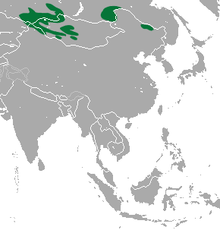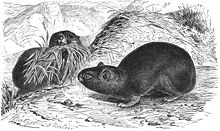Altai Pika
| Altai Pika | ||||||||||||
|---|---|---|---|---|---|---|---|---|---|---|---|---|

Altai Pika ( Ochotona alpina ) |
||||||||||||
| Systematics | ||||||||||||
|
||||||||||||
| Scientific name | ||||||||||||
| Ochotona alpina | ||||||||||||
| ( Pallas , 1773) |
The Altai Pfeifhase ( Ochotona alpina ) is a species of mammal from the family of the Pfeifhasen (Ochotonidae) within the hare-like (Lagomorpha). It lives in the northern mountain regions around the Gobi desert and east and south of Lake Baikal .
features
With a head-to-trunk length of 15.2 to 23.5 centimeters and a weight of 226 to 360 grams, the Altai pika belongs to the larger species of piper, although specimens from China are usually slightly smaller than those found in the north Animals. The fur on the back is dark to chestnut brown in summer; the flanks have a reddish-brown sheen. The ventral side is light brown to whitish yellow. In winter, the fur is pale gray-brown and the head and back of the body have yellow spots.
The skull is compact, but at the same time long and narrow. The incisor window and the palate window are completely separate from each other. The forehead is low and flat and the parietal bones are slightly protruding. The zygomatic arch is strong and a distinct crest is formed on the skull.
The genome consists of a haploid chromosome set of 2n = 42 chromosomes.
distribution
The Altai pika lives in the northern mountain regions around the Gobi desert and east and south of Lake Baikal . It can be found in parts of Kazakhstan , Mongolia , Russia, and in the extreme northwest and northeast of the People's Republic of China . There the subspecies Oa cinereofusca occurs in Heilongjiang Province and the subspecies Oa nitida in the Xinjiang Autonomous Region .
The species prefers rocky mountain regions and tree-covered scree areas as a habitat. The altitude distribution in the Altai ranges from 400 to 2,200 meters, in China the Altai pika only lives at altitudes above 2,000 meters.
Way of life
The Altai Pika usually lives in family groups with a density of 10 to 12 animals per hectare. It is active during the day, but the calls can be heard well into the night, especially during the mating season.
It generally feeds on plants which it collects in bales. Mosses, pine cones and twigs represent a large part of the food. The balls can become quite large and the animals collect up to 30 kilograms of plant parts per hectare, which means that they also play an important role within the ecosystem . Especially in winter after the snowfall, the balls of plants are also eaten by other animals, including the Altai Maral or the reindeer . One of the most important predators of the Altai pika is the sable .
The Altai Pika gives birth to an average of three young animals twice a year. The gestation period is about 30 days and the young animals are 5.8 to 6.0 centimeters long at birth. The lifespan of the animals is a maximum of about six years, but especially in the north of the range it is about three years.
Systematics
The Altai Pfeifhase is assigned as an independent species to the Pfeifhasen (genus Ochotona ) and there the subgenus Pika . Some authors was Northern Pika ( Ochotona hyperborea ) associated with this type, but he is partly due to the different number of chromosomes in the meantime as a separate species. Also Ochotona argentata and the two American species Collared Pika ( Ochotona collaris ) and American Pika ( Ochotona princeps ) were combined to form one species with the Altai pika, but are now all considered to be separate species.
Within the species, the nominate form Ochotona alpina alpina and O. a. changaica , op. cinereofusca and O. a. sushkini are divided into four subspecies. O.a. sushkini was originally considered a subspecies of Ochotona pallasi .
Hazard and protection
The species is classified as “least concern” by the International Union for Conservation of Nature and Natural Resources (IUCN) due to its large distribution area and high population numbers. There are no known major threats to the species population.
literature
- Joseph A. Chapman, John EC Flux (Eds.): Rabbits, Hares and Pikas. Status Survey and Conservation Action Plan. International Union for Conservation of Nature and Natural Resources (IUCN), Gland 1990, ISBN 2-8317-0019-1 , p. 37, (PDF; 11.3 MB).
- Alpine pika. In: Andrew T. Smith , Yan Xie: A Guide to the Mammals of China. Princeton University Press, Princeton NJ 2008, ISBN 978-0-691-09984-2 , pp. 275-277.
Web links
- Ochotona alpina inthe IUCN 2012 Red List of Endangered Species . Listed by: Andrew T. Smith , CH Johnston, 2008. Retrieved October 3, 2012.
supporting documents
- ↑ a b c d e f g Alpine Pika. In: Andrew T. Smith , Yan Xie: A Guide to the Mammals of China. Princeton University Press, Princeton NJ 2008, ISBN 978-0-691-09984-2 , pp. 275-277.
- ↑ a b c d e f g h Ochotona alpina in the IUCN Red List of Threatened Species 2012.1. Listed by: Andrew T. Smith , CH Johnston, 2008. Retrieved October 3, 2012.
- ↑ a b c d Ochotona alpina ( Memento from March 25, 2016 in the Internet Archive ). In: Don E. Wilson , DeeAnn M. Reeder (Eds.): Mammal Species of the World. A taxonomic and geographic Reference. 2 volumes. 3. Edition. Johns Hopkins University Press, Baltimore MD 2005, ISBN 0-8018-8221-4 .
- ↑ a b Joseph A. Chapman, John EC Flux (Ed.): Rabbits, Hares and Pikas. Status Survey and Conservation Action Plan. International Union for Conservation of Nature and Natural Resources (IUCN), Gland 1990, ISBN 2-8317-0019-1 , p. 37, (PDF; 11.3 MB).

